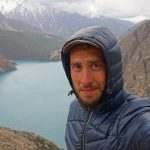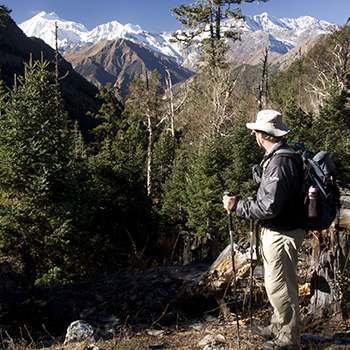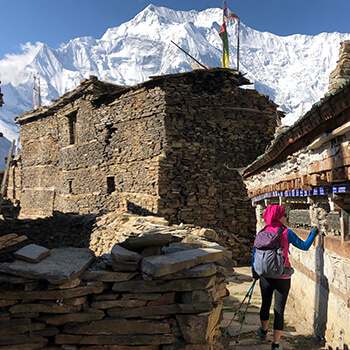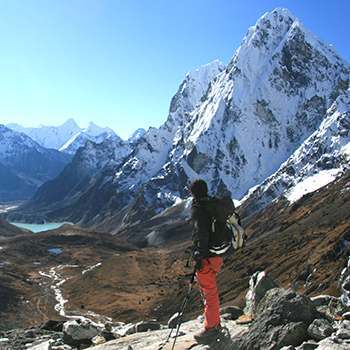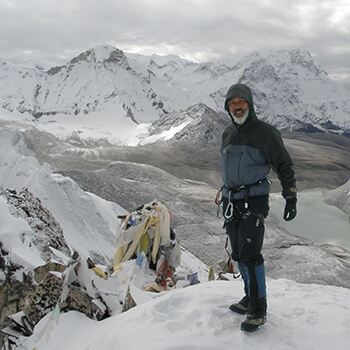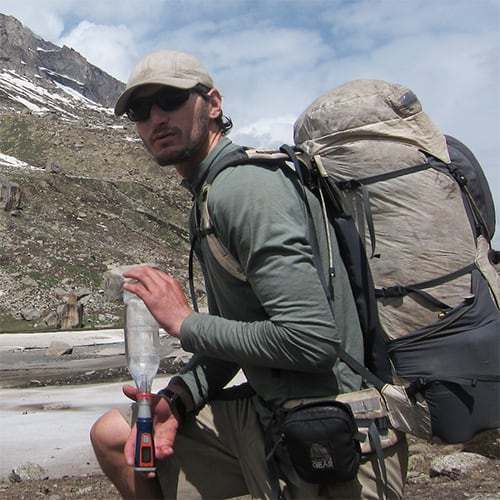
Across the Himalaya with Justin Lichter
Setting the stage
Tons of people as the question “Why did you do it?”, or “Why did you go there?” The answer is pretty simple. I want to see new places, explore new areas, and challenge myself in different conditions. These are the same reasons that I head out on all of my expeditions.
Part of the fun of the hike is the challenge of the planning. It helps get me excited about the trip. I get to play with maps of different scales and try to weave them together like a jigsaw puzzle. The goal is always to connect as much backcountry area, big mountains, deep river valleys, and anything relatively unpopulated, with the least amount of walking on roads. Some places this works like a charm and other places it leaves you disgruntled and hating life while you are plodding along on hot asphalt with cars whizzing by for what seems like an eternity. Never the less “the route” is an always changing plan once I see what is actually working when I am “on the ground”. Knowing that my route was great or needed some tweaks, and having dealt with everything that entails makes the trip that much more rewarding.
Back in 2011, There wasn’t much information out about a route through the Himalayas when we undertook this project. Robin Boustead was putting together a Great Himalaya Trail, so we got some information from him. We used websites, Lonely Planet hiking books, road maps, and anything else we could find. In a few cases we read historical biographies about old British and Kiwi explorers heading into the Himalaya. We planned for resupplies, extra equipment, and tried to foresee unforeseen circumstances since we knew we wouldn’t be able to get much gear once we were there. We devised a plan to leave our extra kit in a duffel at a hotel in Kathmandu. We would then come back to Kathmandu from a couple of access points on the hike to swap out gear and resupply. In addition the information we collected didn’t always jive and have us well informed about our route. We were getting mixed signals about a lot of passes and how technical they were and what equipment we might need on them. We have a different mindset than most people that head out into the Himalaya. We are coming from a long-distance hiking and ultralight background compared to a mountaineering or trekking background. We were doing this trip with as little as we could get away with and trying to use gear items for multiple purposes. We spent a lot of time planning our gear and figuring out how we could shave ounces and then hoping that our ultralight equipment would work in the biggest mountains in the world.
The preparation was quite different for this trip then a lot of the others that I have headed out on. Basically, it was a whirlwind. I left the United States on March 21. A little early for me since I am typically working as a ski patroller through the winter. I worked up until the last week. I trained for hiking by skiing (nordic, backcountry, and telemark). I guess you can say it is cross training. It didn’t help that we were having a record setting winter and got blasted with 2-3 weeks of straight snow around the time we were leaving. It was a nightmare. Everything took so much longer to get ready and get around. My driveway hadn’t gotten plowed for over a week because we had over 15 feet of snow and the plows couldn’t keep up. My car couldn’t make it up the driveway so just getting the duffel bags to the car and getting out to sort out any last minute errands was an adventure. I wasn’t sure if I was even going to make it to the airport.
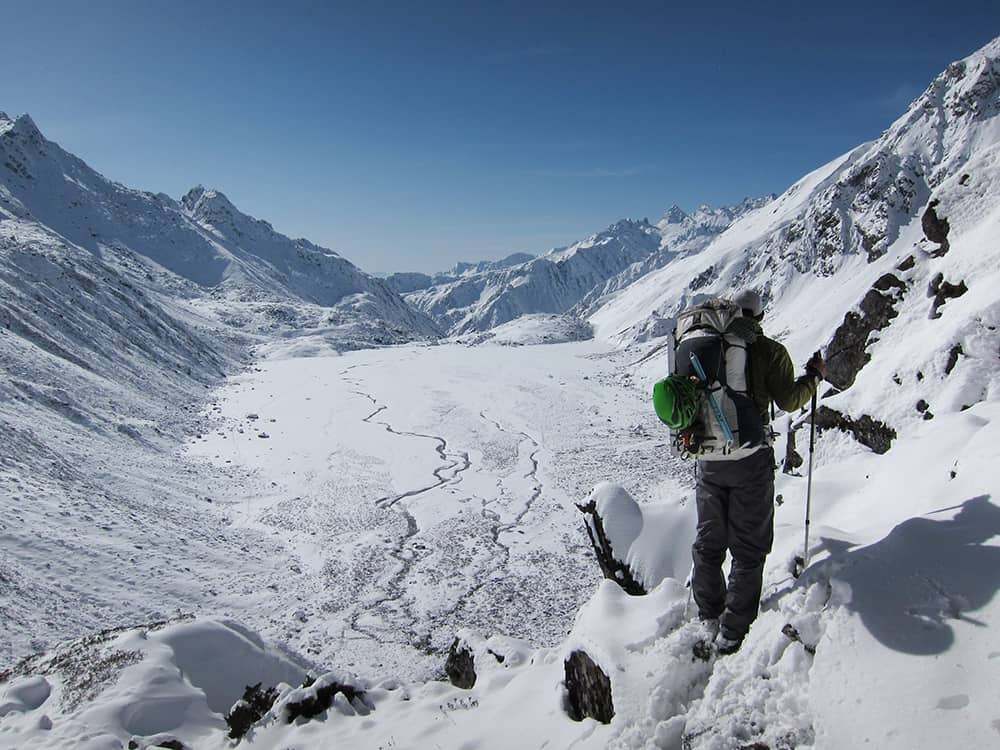
The Trek Begins
I stepped off the plane in Kathmandu and was relaxed, nervous, and excited. It was great to have put the madness of pre-trip details behind me but now I had to deal with the mayhem of Kathmandu. I hate the onslaught of touts and taxi drivers that most 2nd and 3rd World countries have when you exit the airport. I was ready for it as I exited with my two huge, heavy duffel bags. I naturally assume everybody is trying to rip me off. After a while I finally agreed and got a ride into Thamel, the touristy district of Kathmandu. We still needed to pick up maps, get permits, and scout out resupply options before we set out on the hike.
Thamel was intimidating. I spiderweb of interlacing tiny streets with no rhyme or reason and a million people wandering through them, all the while cars, motorcycles, and scooters are trying to weave through as well. It was sensory overload and it smelled like crap. I will never forget the putrid smell of the rotting garbage on the streets.
My hiking partner was to arrive the next afternoon. That didn’t go as planned. He didn’t recheck his ticket and assumed his flight left at 12 noon but it was 12 midnight. He missed his flight so they rescheduled him for the next day. I wandered around and picked up the maps for the hike and tried to get acquainted with the city. I saw chickens and meat selling at street vendor that were days old and rotting in the sun and skinned goats and pigs sitting out with flies on them. Resupply options weren’t looking promising. By 3:30 in the afternoon the jet lag hit me and I was done for the day. For the next 3 days the jet lag from three days of travel from San Francisco to Seoul to Bangkok and finally into Kathmandu left me paralyzed by 3:30PM.
We knew the weather window is tiny for a trip of this magnitude. There are basically 2-3 months in the spring and 2-3 months in the fall before the onslaught of monsoonal moisture or impending winter weather. The monsoons move into Nepal by June and then sweep from east to west into India. We were going to have to maximize our time on the trail and move fast to keep ahead of them and to finish in one season. No names come to mind for people that had finished in one season prior, but if anybody could do it we knew we could because of our ultralight backgrounds and our tendencies to hike over 30 miles per day.
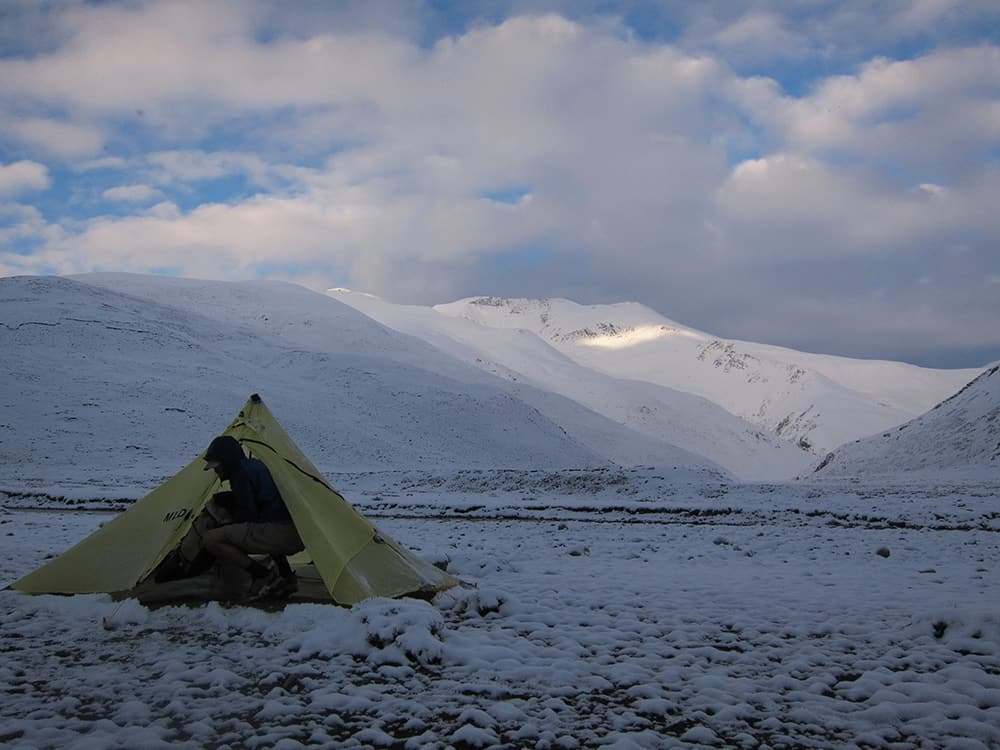
The driver seemed to be the only one having fun playing rally car on bumpy dirt roads with sheer cliffs on the side. After a ridiculous day of 16 hours of sitting in a cramped jeep with 10 other people, where I couldn’t straighten my neck or unbend my legs from pressing into the metal bars on the seat in front of me, I was happy to still be alive as we finally arrived at Taplejung, our eastern terminus. It would have been an easy one hour flight but the airport was closed to resurface the runway. We weren’t used to Nepali time yet, but we would soon get the hang of things.
We decided to hire a guide for the first 3 weeks through the Nepal Himalaya during our traverse of the Himalaya range. It seemed like a good idea since we didn’t speak the language and were heading into unfamiliar terrain with some technical passes. In addition Robin Boustead had strongly recommended having a guide. We obliged and interviewed for a guide in Kathmandu before we set out. We met one. He didn’t speak much English. From what we could tell he was telling the truth in having done the technical passes. He also seemed willing to push himself when we told him our typical daily mileage and hiking hours. After all we were breaking in to hiking shape also so we figured it would work out well to force us to slow down a bit. Normally we stay clear of guides by any means possible. I was forced to hire a couple when I hiked across Africa due to government regulations for certain areas and didn’t have good experiences then either. We are not the typical clients. We planned on using this guide for about 200 miles, or about 1/10th of the trip, but in reality he only used us for about 100 miles. Robin had recommended using a guide for the entire hike, but there was no way we were going to adhere to that recommendation because that would have been sacrificing our trip and there would have been no way we would have been able to complete the hike in one season with a non-ultralighter tagging along.
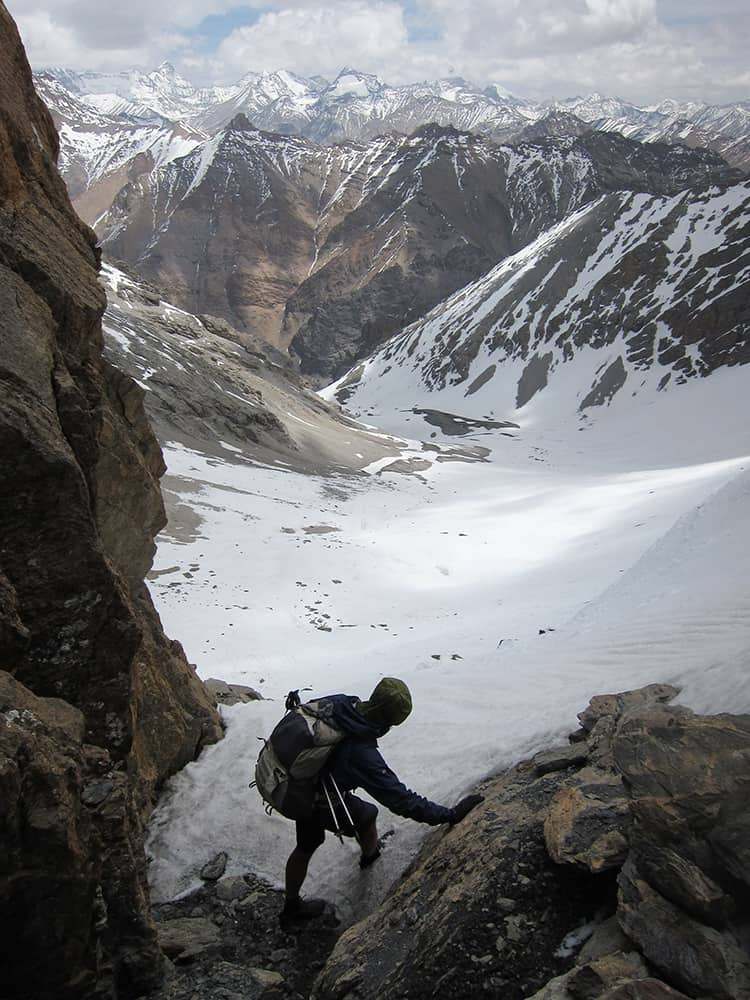
Life on the Trail
From Day 1 we were making concessions. We told him our usual hiking schedule and routine of hiking for three hours and then taking a 45 minute break and repeating that until it got dark. I’m not sure if it was the language barrier, shear stubbornness, or bad business practice but he would never learn to adjust to his client’s schedule. His pack was heavy with equipment and he wasn’t even carrying any food. Our packs were stuffed with 10 days of food. Our pace was going to pick up as our packs lightened every day, but his pack would always be heavy. This was going to be a problem. We needed to give him a “sherpa shakedown”. He had sweat pants, jeans, extra shorts, and tons of extraneous clothing and equipment. He didn’t have food and the Nepali meal schedule is different than our Western meal schedule. He would have to stop at random intervals, usually around 10AM, 2PM, and 7PM, when we passed people’s houses and ask them to cook him some food. This usually set us back for over an hour. Our breaks were staggered and it was burning a lot of hiking time. Often he would make arrangements to stay at somebody’s house during a break when we had planned to hike on. It was frustrating. In addition we were ascending over passes above 4700 meters (15510 feet). We were postholing for miles and navigating through white outs. The guide had clearly never been to these passes. He was following in our tracks. Never volunteering to lead or break trail and he had no idea where we were or how to read a map. We would pull out the map to navigate and he would point to a river when we would be on a pass or point to a village we had passed the day before. When we passed a village prior to our first pass over 5000 meters, he decided to hire somebody from the village with his own money to help us find the pass. This was completely unnecessary. We were doing all of the navigating but he didn’t know where he was and he was probably feeling a bit less macho since we were actually guiding him. He probably also wanted some Nepali company. We later learned another reason that led to this decision. We had to camp at a high camp the night before the pass. He was scared to camp and sleep in the tent by himself. The next night we were a bit behind schedule because we we postholed for hours over the Lumbha Sambha La Pass so we camped again. This time after setting up his tent for him, he had to sleep by himself inside. He woke up screaming at 3AM. Pepper and I woke up and asked him what was going on. We couldn’t understand the broken English so rolled over and went back to sleep. His headlamp was on the rest of the night. When morning came we asked him again what had happened. He said a Yeti had unzipped the door of his tent and broke in. It then stood on his chest and started to strangle him and attack him while another one watched from a few feet outside the tent. We were suspicious. He was adamant about it. He said that Yetis were all over the area and that they had tried to come back a few times during the night after he had woken us up. He had stayed awake the rest of the night and had been lucky and scared them off. I asked him what they looked like. He described little black, hairy creatures that were about 2 feet tall and walk on two legs. The next few days he told all of the villagers what had happened. Each time Pepper and I laughed hysterically. To make matters worse his body was hurting from his pack. He was looking for excuses to stop early and at times we had to carry things for him and other times he hired locals to carry some of his gear. We were his porters and his guide. He should have been paying us for our services. We knew we had to get the guide out of the backcountry for his own safety.
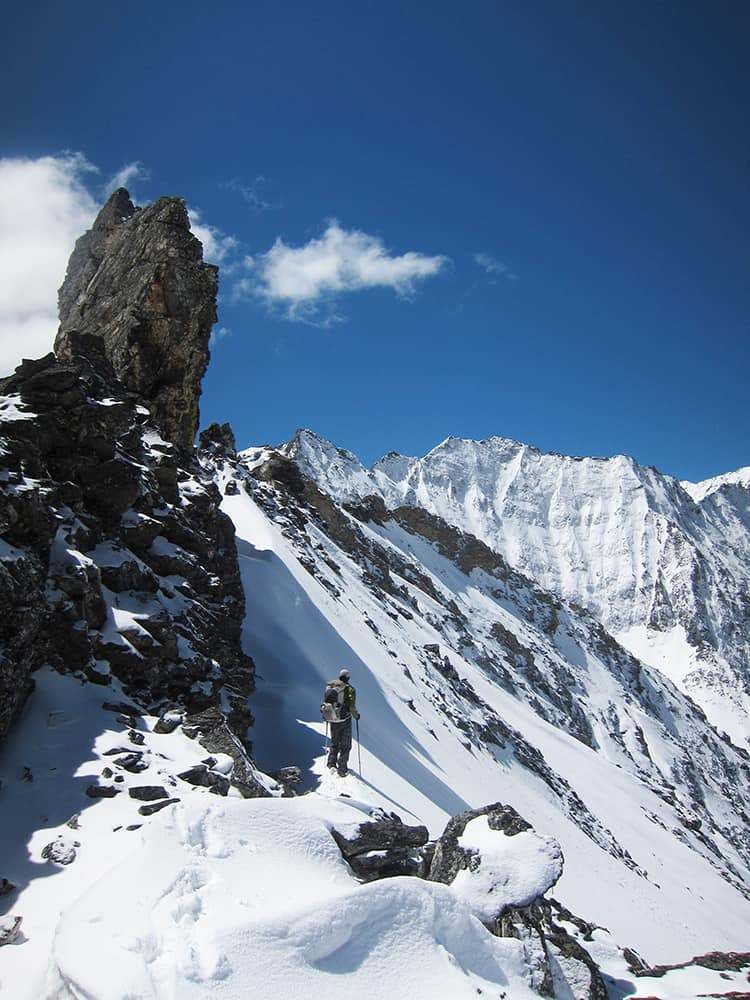
Surprises and problems on the trail
We brought the guide back home to Kathmandu and things immediately started to go more smoothly, besides for the classic Nepali hiccups. 2011 was supposed to be a big tourism year so they were promoting “0 strikes in 2011”. That definitely wasn’t the case. They had at least 3 or 4 strikes during the 2 months we were there. Often we would lose days because we couldn’t get back out of town from a resupply and get back to the trail. We took 47 hiking days to get across Nepal but it took an additional 21 days of resupplies, waiting for permits, and waiting around for strikes to end (normally we only take about 1 rest day per month). Besides for that we were breaking into hiking shape and picking up the pace now without the guide. We routinely did 2000 meters of climbing and descent in a day, sometimes over 3000 meters. Days we started referring to as “Double-Doubles”, since we were also dreaming of In-N-Out Burgers. We averaged about 22 miles per day through Nepal.
Once we finished Nepal I continued on through India. My partner had to go back home to start work. I hiked about another 500 miles or so through India and finished the traverse of the Himalayas at the Pakistan border. We had originally intended to do 150 miles though Pakistan but things got really heated during our hike because of the assassination of Osama Bin Laden. I reevaluated the plans and decided to end at the Line of Control between India and Pakistan, which was very heavily militarized and pretty scary in its own right.
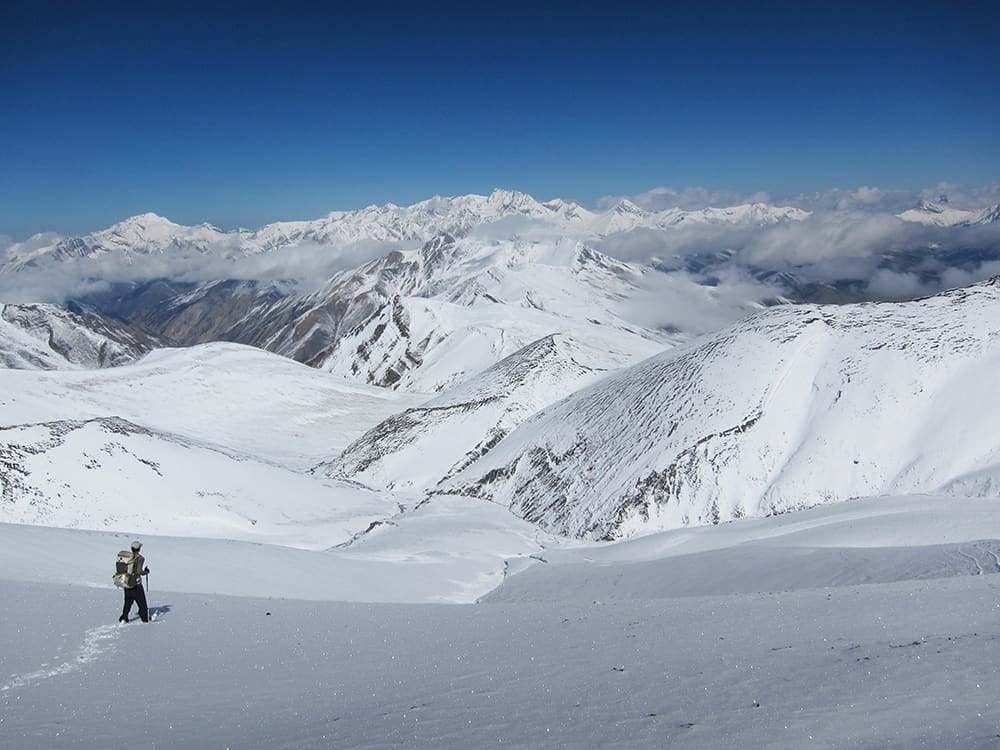
The home stretch
The last 13 days through Nepal were the toughest of the trip. We had a 10 day stretch through the remote area of Dolpa and then a quick resupply in the town of Gamghadi, before a 3 day dash to the end of Nepal. The 10 day stretch through Dolpa was probably the most difficult stretch of hiking I have done. It included 8 passes over 5000 meters, countless hours of postholing, numerous climbs over 3000 meters, uncooperating weather, and utterly amazing scenery. At times the postholing through rotten snow at 19000 feet would slow us down to 100 yards per hour. It was grueling and frustrating. We joked that if Pepper could see my heart beating through my back and glowing like E.T. that we had to reevaluate the situation. We couldn’t get enough calorie dense food to keep our weight on. The typical Nepali cuisine is dhal bhat, which is rice and lentils, and they eat that twice a day and that’s basically all they eat. We tried to avoid the dhal bhat as much as we could because we came to the conclusion that we were probably having a net deficit in calories with how our stomachs would feel the next day. I don’t have much extra weight to lose anyway and I probably hit 145 pounds, a weight I haven’t seen since middle school. I have put our start and end shots next to each other to compare and the emaciation is amazing. Unlike any other hike I have ever done.
Upon finishing Nepal the food got a bit better in India and I was able to maintain my already skinny body weight. In addition, I really like the garlic and cheese naan and I was able to find Domino’s pizza a couple of times so I could stock up on calories in a more common method. Binge when I would get to a town. People were amazed at the quantities of naan, Coke, and pizza I was putting away. It still wasn’t helping me gain any weight though.
A month later when I returned home the fun began. All of the delicacies I had been dreaming of stocked the refrigerator. Ben and Jerry’s in mass quantities, yogurt, dark chocolate, salads, cheeses, and chocolate soy milk. I am now back up to 156 pounds.
On Reflection, what it all means.
It is hard to say what I have learned and taken away from the trip. The whole experience is still settling in. More than a lot of other hikes that I have done there was definitely a sense of accomplishment at the end. It was a grueling, tough trip. I lost more weight than on almost any other hike. I met some genuine and amazing people that would have given me the one shirt that they owned right off of their back. I experienced selflessness, resourcefulness and simplicity, as well as rudeness and ogling. I am humbled and grateful. Ultimately I am speechless. I wish I had seen the Yeti too.
See Justin’s website for more info about his adventures: http://www.justinlichter.com
And for more info about his GHT trek: www.justinlichter.com/2011-great-himalaya-trail/





